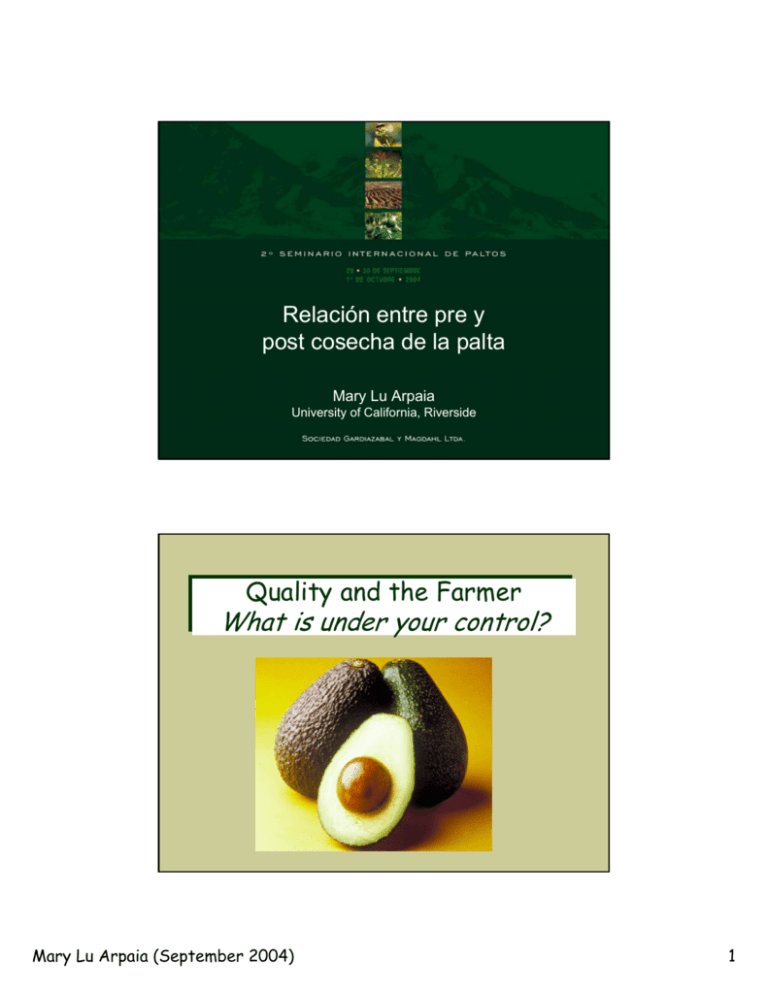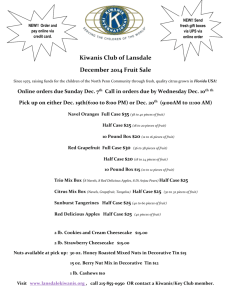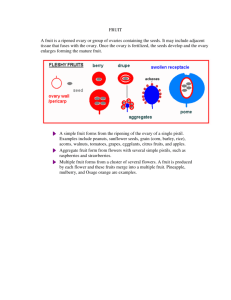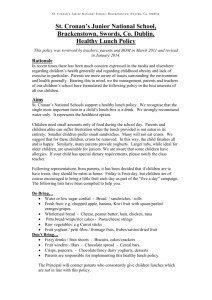Relación entre pre y post cosecha de la palta
advertisement

Relación entre pre y post cosecha de la palta Mary Lu Arpaia University of California, Riverside Quality Quality and and the the Farmer Farmer What What is is under under your your control? control? Mary Lu Arpaia (September 2004) 1 The The continuum continuum The most important thing to remember is that there is a continuum from the grower to the consumer The steps in the continuum Grower – Packer – Distribution - Consumer Quality Quality The inherent properties or attributes of a product which determines its relative degree of excellence Mary Lu Arpaia (September 2004) 2 Avocado Quality Attributes Can mean many things, depending at what point one is assessing the fruit How do you as a grower perceive “quality”? Appearance Factors 4 Fruit size and shape, peel texture 4 Freedom from defects such as insect scarring, wind damage, limb rub Avocado Avocado Quality Quality Attributes Attributes cont. cont. Past the grower – the Packinghouse 4 Appearance to maximize packout of #1 fruit 4 “History of the grove” – STRESS, LOCATION 4 Picking conditions – HOT, DRY vs WET 4 Delay from harvest to packer 4 Time of season - MATURITY Mary Lu Arpaia (September 2004) 3 Avocado Avocado Quality Quality Attributes Attributes cont. cont. Past the grower – Distribution 4 Source of fruit at certain times of the year - MATURITY 4 Product Uniformity 4 Ability to take ethylene in a predictable manner 4 Have some storage life to adapt to marketing situations Avocado Avocado Quality Quality Attributes Attributes cont. cont. Past the grower – Consumer 4 Source of fruit? California vs other??? 4 Product Uniformity 4 Ability to predict when ready to eat 4 Freedom from defects 4 Eating quality Mary Lu Arpaia (September 2004) 4 Problems that that you you can can find find at at Problems the retail retail level level with with avocados avocados the Body Rot Stem End Rot Mary Lu Arpaia (September 2004) 5 Postharvest Postharvest Diseases Diseases Anthracnose Body Rot Dothiorella Stem End Rot Alternaria Stem End Rot Internal Bruising Seed cavity Air pocket Different symptoms of internal bruising Bruising underneath Peel Mary Lu Arpaia (September 2004) Bruising underneath Peel Extending into the flesh 6 Peeling ease ranging from extremely difficult (left) to very easy (right) Shriveling Flesh/Mesocarp Discoloration Preharvest Preharvest factors factors influencing influencing fruit quality quality fruit Mary Lu Arpaia (September 2004) 7 Preharvest Preharvest Factors Factors • • • • Environmental • PGRs Rootstock/Scion • Irrigation Spacing and Pruning • Nutrition Pest Management These factors are interactive and influence each other How How preharvest preharvest factors factors may may influence influence fruit fruit quality quality • Development and maturation • Physical effects on quality and packout • Susceptibility to physiological and pathological breakdown Mary Lu Arpaia (September 2004) 8 Climate Climate and and environment environment • Temperature • Wind • Rainfall • Air quality • Fruit position on tree Beware of discoloured stems Freeze Damage Damage Freeze = Cold Stress = Cold Stress Can see increased decay and low temperature damage after storage Effects could last for several weeks/months Mary Lu Arpaia (September 2004) 9 40 Unsound Rainfall %Unsound or Ra infal l (mm) 35 30 25 20 15 10 5 0 1/ /1 10 0/ /1 31 01 20 01 20 01 20 0/ /1 21 01 20 0/ /1 11 01 20 0/ /1 01 01 20 9/ /0 21 01 20 9/ /0 11 01 20 9/ /0 01 Date More More body body rots rots develop develop when when fruit fruit are are harvested harvested during the rainy period than dry summer during the rainy period than dry summer months months Infected fruit (%) 40 Body Rots Stem end rots 30 Winter Summer 20 10 0 1 2 3 1 2 3 Avocado grove location Mary Lu Arpaia (September 2004) 10 During During rainy rainy periods periods (like (like January), January), Colletotrichum Colletotrichum is is most common. During dry periods, Colletotrichum remains most common. During dry periods, Colletotrichum remains common common but but Dothiorella Dothiorella and and other other fungi fungi are are found found Things Things to to ponder ponder • Should freeze damaged fruit go into the market stream? • Should you be tempted to pick up fruit from the ground? • Should you pick after rain? Mary Lu Arpaia (September 2004) 11 Rootstock and and Variety Variety Interactions Interactions Rootstock Effect of avocado cultivar and clonal rootstock on fruit quality following 28 days at 5.5C 100 % freedom from chilling injury G755C G6 80 Duke 7 60 40 20 0 Fuerte Hass Kohne and Kohne, 1992 (unpublished) a b 75 Rootstock and and Rootstock Variety Variety Interactions Interactions SV CV CD b a ns b b 50 b a Results from Australia 20 yr-old trees a 25 0 1999 2000 1999 Diffuse discolouration Rootstocks affect ‘Hass’ avocado fruit rots and physiological disorders Marques, Hofman 2002 Mary Lu Arpaia (September 2004) 4 wks @ 5C 2000 Vascular browning Flesh volume (%) Fruit acceptability (%) 100 40 b SV Seedling Velvick CV Clonal Velvick Duke 7 D7 30 a c 20 a b 10 a Non-stored Stored 12 Rootstock and and Rootstock Variety Variety Interactions Interactions Fruit skin b 0.40 ab Ca (g kg-1 DW) ns 0.35 a 0.30 Fruit flesh 0.30 c b a 0.25 0.20 Seedling Velvick Clonal Velvick Clonal Duke 7 b a a 2000 1999 Year Rootstock Rootstock influences influences Calcium levels levels in in Calcium the fruit the fruit Effect of long-term irrigation regimes on the browning potential of 'Fuerte' avocado after 30 days storage 1.4 PPO activity 1.2 1.0 0.8 0.6 0.4 0.2 0.0 35 kPa 55 kPa 80 kPa Irrigation Regime J.P. Bower, 1988 Irrigation effects effects on on fruit fruit quality quality Irrigation Increasedbrowning browningpotential potentialfollowing following Increased storage = mesocarp discoloration storage = mesocarp discoloration Mary Lu Arpaia (September 2004) 13 Effects of tree vigor on fruit quality Individual tree yield records were maintained Based on overall tree yield and storage quality the following observations were made: In vigorous, low yielding trees all forms of chilling injury were observed in higher amounts following 28 days at 5.5C Low yielding trees had lower pulp calcium, zinc and manganese D. Smith, 1992 (unpublished RSA) Anthracnose (1-5) Tree yield and fruit rots (Australia) Higher yield for same size tree may also reduce postharvest decay r = 0.81** 4 3 2 40 80 120 160 200 240 Associated with smaller fruit and higher fruit Calcium -1 Fruit yield tree (kg) Hofman, Vuthapanich, Whiley, Klieber, Simmons 2001 Mary Lu Arpaia (September 2004) 14 Avocado Seasonal Calcium Concentration 10 8 6 , + " , + " ! 4 , + " ! 2 0 Tree Tree vigor vigor influences influences calcium calcium levels levels in in the the fruit fruit Fruit Ca (mg/kg DW)(X1000) 0 2 ! 4 6 , + " ! 8 ! Vigorous 'Fuerte' " Non-Vig 'Fuerte' + Vigorous 'Hass' , Non-Vig 'Hass' Calcium Calcium affects affects the the rate rate of ripening of ripening , + " ! , + " ! , + " ! , " + ! , " + ! , " + ! , " + ! , " + ! , " + ! 10 12 14 16 18 20 22 24 26 Weeks after Fruit Set Regression of Days to Fruit Ripening and Calcium Concentration G.W. Witney et al., 1990 y = 0.0056x + 4.856, r = 0.92** 16 Days to Ripen ! 14 12 10 8 6 ! 0 500 1000 1500 2000 2500 Calcium (mg/kg DM) Witney et al., 1990 Canopy Management/Pruning May have have an an effect effect on on fruit fruit quality quality May Aim at at fruit fruit requirements requirements not not wood wood Aim Mary Lu Arpaia (September 2004) 15 % of flesh affected a 1.8 1.6 1.4 1.2 1 0.8 0.6 0.4 0.2 0 2001 2002 ab b Unpruned Pruned after harvest Pruned again in summer Diffuse discoloration Increased Increased vegetative vegetative vigor vigor from from pruning pruning can can result in increased result in increased decay decay and and physiological physiological disorders disorders % of flesh affected 4 a 3 a ab 2 1 b 0 Unpruned P runed aft er harvest P runed again in summer Leonardi, Whiley, Hofman The relationship between subsoil (Ca+Mg)/K ratio and the incidence of grey pulp in avocado 50 The role role of of The plant nutrition nutrition plant % Grey Pulp 40 30 1990 r=-0.49 20 1989 r=-0.68 10 0 P runed in summer + Sunny 1.4 2.4 3.4 4.4 5.4 6.4 7.4 Subsoil (Ca+Mg)/K mg per kg The influence of fruit calcium and zinc levels on the incidence of pulp spot DuPlessis and Koen, 1992 70 ppm No Pulp Spot 60 Pulp Spot 50 40 30 20 10 0 Calcium (*) Zinc (**) Vorster and Bezuidenhout, 1988 Mary Lu Arpaia (September 2004) 16 HIGH HIGH NITROGEN NITROGEN • EXCESSIVE VIGOUR • LACK OF CALCIUM, BORON AND CARBOHYDRATES TO FRUIT • MAY RELATE TO CARBOHYDRATE TRANSPORT • ENZYME CO-FACTORS • CELL FUNCTION The influence of nitrogen nutrition on moderate/severe chilling injury after 6 weeks at 5C. 80 60 % Moderate/Severe " " " " " 40 " " " " " 20 0 1.77 " " " 2.08 2.28 2.46 2.65 2.86 3 Leaf Nitrogen (%) The influence of nitrogen nutrition on the time to eating ripeness. Days to <1.5 lbf The role role of of Nitrogen Nitrogen The on ‘Hass’ ‘Hass’ fruit fruit quality quality on 8 % % % % 6 & 4 2 ' 0 1.77 % % % % % % 0 wks % % % % & & ' ' & & ' & ' 2.08 & ' ' 2.28 & ' & ' 2.46 & ' & ' 2.65 & ' 3 wks & 6 wks ' 2.86 & ' 3 Leaf Nitrogen (%) Mary Lu Arpaia (September 2004) 17 Diffuse discoloration (1-5) r = 0 .8 3 * * 2 1 200 300 400 Calcium Calcium fruit fruit levels levels influences influences susceptibility susceptibility to to physiological physiological problems problems and and decay decay 500 -1 C a lc iu m c o n c e n tra tio n (m g k g ) Anthracnose severity (1-5) 3 4 r = 0.88** 3 2 1 200 300 400 500 -1 Calcium concentration (mg kg ) Hofman, Vuthapanich, Whiley, Klieber, Simmons 2001 Flesh Flesh minerals minerals and and diffuse diffuse discolouration discolouration Year 1994 1995 Holding conditions 7°C, 3 wks 7°C, 5 wks 2°C, 5 wks r value Ca Mg -0.07 -0.13 0.30 0.31 -0.83 ** -0.75 ** K 0.55 * 0.06 0.51 * Hofman, Vuthapanich, Whiley, Klieber, Simmons 2001 Mary Lu Arpaia (September 2004) 18 INTERNAL DISORDERS • TRADITIONALLY CALCIUM IMPLICATED SUGGEST THAT • MULTI-FACTOR PROBLEM • CALCIUM NOT ALWAYS MAIN FACTOR TO TREAT SOLUTIONS SOLUTIONS • ENHANCE FRUIT SINK STRENGTH FOR: – CRITICAL ELEMENTS (VARIES WITH SITE) – CARBOHYDRATES – CRITICAL STAGES IN FRUIT DEVELOPMENT Mary Lu Arpaia (September 2004) 19 PRE-HARVEST GROWING CONDITIONS INTERACTION BETWEEN * pre-harvest orchard temperatures mainly external defects * vegetative growth external and internal defects MASKING EFFECT * water stressed trees Harvesting Operations Operations Harvesting • • • • Minimum Maturity Standards Harvesting Methods Delay between field and packer Harvesting conditions Mary Lu Arpaia (September 2004) 20 Quality Quality vs. vs. Maturity Maturity Immature 6 Poor quality when ripe 6 More shriveling and physical damage Mature 6 Good quality when ripe 6 Longest postharvest life Overmature 6 Poor flavor 6 More Physiological disorders, decay Immature Fruit Quality Problems Mary Lu Arpaia (September 2004) 21 Physiological disorders accentuated with low maturity fruit External Chilling Injury Flesh Discoloration Fruit quality to consumers is limited by harvest maturity: – Immature – watery, shriveling, inconsistent ripening, physiological disorders, susceptible to decay – Overmature – can be dry, rancid, seed germinating and more susceptible to decay Mary Lu Arpaia (September 2004) 22 Checkerboarding = Ripening Variability Difficult to predict time of ripeness Great variation in the days to ripe within a package even with ethylene treatment RESULT: Lack of ripe uniformity means more loss at point of purchase Poor RIPE Skin Colouration Mary Lu Arpaia (September 2004) 23 Stringiness TASTE TASTE California 2002-03 results with Ventura Co. Hass fruit 2002 - 2003 Hass Maturity Project (Preliminary Results) ALL DATA Hedonic score vs. Dry weight 9.0 8.5 8.0 7.5 Like moderately Average Hedonic Score 7.0 6.5 Like slightly 6.0 Clearly at lower DW values, acceptability of fruit is marginal 5.5 Neither like or dislike 5.0 4.5 Dislike slightly 4.0 3.5 Dislike moderately 3.0 2.5 y = 0.1874x + 1.6404 2 R = 0.6052 2.0 1.5 Data suggest that for a score of 6 the CA dry matter will be approximately 23% 1.0 12 13 14 15 16 17 18 19 20 21 22 23 24 25 26 27 28 29 30 31 32 33 34 35 36 37 38 Percent Dry Weight Mary Lu Arpaia (September 2004) 24 Discrete patches (chilling damage) Skin spotting (Nodule damage) Physical Physical damage damage and and chilling chilling 25 Discrete patches (% area) Skin spotting (% nodules) % damage 20 15 10 5 g in ac k Af te rp rb ru sh in g he d At s Af te ld fie In H an d ha r ve st ed 0 Mary Lu Arpaia (September 2004) 25 Physical Physical damage damage and and chilling chilling The The importance importance of of temperature temperature management management when when harvesting harvesting Mary Lu Arpaia (September 2004) 26 Protecting the fruit after harvest from high temperature has implications in the market place Temperature (F) 105 95 During the course of the day, fruit in the TOP 12” of the bin with no protection can reach temperatures in EXCESS of 100 F whereas covered bins or those held in the shade can maintain temperatures close to ambient 85 75 TOP 65 55 1100 1130 1200 1230 1300 1330 1400 1430 1500 1530 Time Air Uncovered Space Temperature (F) 105 BOTTOM 95 Fruit at the BOTTOM of the bin stay cool during the day 85 75 65 55 1100 1130 1200 1230 1300 1330 1400 1430 1500 1530 Time Air Uncovered Space Source: Arpaia, M. L., 1994; ‘Hass’ fruit harvested from Riverside county. What is the outcome of high temperatures in the field after harvest? % Decay 40 % Moderate/Severe Discoloration 40 30 30 20 20 10 10 0 0 Uncovered Space Blanket Uncovered BOTTOM TOP Space Blanket Uncovered Space Blanket BOTTOM Uncovered Space Blanket TOP Fruit from the BOTTOM of the bin (lower temperatures) had lower decay and less chilling injury after storage at 41F and ripening. However, fruit from the TOP of the bin, which were warmer, had higher levels of both decay and chilling injury. This is especially true for the fruit which came from the uncovered bins. Source: Arpaia, M. L., 1994; storage was for 6 weeks at 41F. Mary Lu Arpaia (September 2004) 27 Considerations Considerations in in the the grove grove • Keep fruit in a cool place, out of the sun • Work with packinghouse to minimize delays from time of harvest to cooling • Avoid picking when temperatures are high especially with late season fruit • Avoid picking during or shortly after a rain event – more decay • Worker Safety; HAACP considerations for the future Limitations to to avocado avocado Limitations postharvest handling handling postharvest 9 Fruit maturity and quality at time of ripeness – Immature – watery; inconsistent ripening – Overmature – can be dry; seed germination and more susceptible to decay 9 Time after harvest and how fruit are managed – Increased risk of physiological disorders • Stage of ripeness – Ripe for tonight – More difficult to handle “ripe” fruit Mary Lu Arpaia (September 2004) 28








